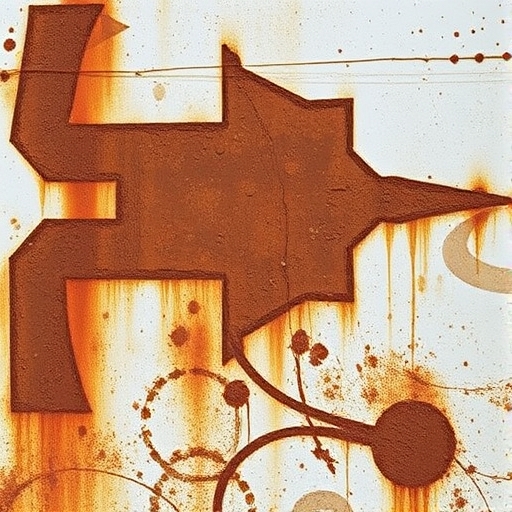Can You Paint Over Rust? A Comprehensive Guide
Rust is a common problem for metal surfaces exposed to moisture and air. Whether it’s on your car, garden furniture, or tools, rust can not only affect the aesthetics but also compromise the integrity of the metal. Many DIY enthusiasts and homeowners wonder, “Can you paint over rust?” In this article, we will explore the answer to this question, the right techniques, and the best products to use.
Understanding Rust
What is Rust?
Rust is a form of iron oxide that occurs when iron or its alloys corrode. It forms when iron reacts with oxygen in the presence of moisture. The chemical reaction can be summarized as follows:
[ text{4Fe} + text{3O}_2 + text{6H}_2text{O} rightarrow text{4Fe(OH)}_3 ]
This results in hydrated iron(III) oxide, which we commonly know as rust.
Why is Rust a Problem?
- Structural Integrity: Rust weakens metal structures, making them more prone to breakage.
- Aesthetic Issues: Rust can make objects look old and neglected.
- Increased Repair Costs: If left untreated, rust can lead to more extensive damage that may require expensive repairs or replacements.
- Light Rust: Can often be treated and painted over.
- Heavy Rust: May require more extensive treatment or replacement of the affected area.
- Remove dirt, grease, and loose rust using:
- Wire brushes
- Sandpaper (preferably 80-120 grit)
- Power tools with wire attachments (for heavy rust)
- Mechanical Methods: Scraping, sanding, or grinding to remove rust.
- Chemical Methods: Using rust removers or converters that chemically neutralize rust.
- Rust Converter: A product that converts rust into a stable compound that can be painted over.
- Rust Inhibitor: A primer designed to prevent rust from forming under the paint.
- Always wear gloves and a mask when dealing with rust and chemicals.
- Work in a well-ventilated area.
- Rust-Preventive Paint: Designed specifically to prevent rust and corrosion.
- Oil-Based Paint: Provides a durable finish and adheres well to rusty surfaces.
- Acrylic Paint: Flexible and can be used for outdoor applications but may require a primer.
- Use a brush or spray to apply a thin layer.
- Allow it to dry according to the manufacturer’s instructions.
- Use a brush, roller, or spray can for application.
- Apply multiple thin coats rather than one thick coat.
- Test First: Always test your paint on a small area to ensure adhesion and compatibility.
- Weather Considerations: Avoid painting in high humidity or extreme temperatures.
- Use Quality Tools: Invest in good brushes or sprayers for a smoother finish.
Can You Paint Over Rust?
The Short Answer
Yes, you can paint over rust, but it is crucial to prepare the surface adequately to ensure the paint adheres properly and provides long-lasting protection.
The Long Answer
While some paints are designed to adhere to rust, simply painting over rust without proper preparation can lead to peeling, flaking, and further corrosion. Here’s what you need to consider:
1. Surface Preparation: The rust must be removed or treated to ensure proper adhesion.
2. Choice of Paint: Not all paints are suitable for use over rust. Special rust-inhibiting paints are available.
3. Application Process: Following the correct application process is essential for the longevity of the paint job.
Preparing Rusty Surfaces for Painting
Step-by-Step Preparation
1. Assess the Rust
2. Cleaning the Surface
3. Rust Removal Methods
4. Treating the Surface
Safety Precautions
Choosing the Right Paint
Types of Paint for Rusty Surfaces
Recommended Products
| Product Type | Example Brands | Key Features |
|---|---|---|
| Rust Converter | Loctite, Permatex | Converts rust to a stable form |
| Rust-Inhibiting Primer | Rust-Oleum, Zinsser | Provides a strong base for paint |
| Rust-Preventive Paint | Krylon, Valspar | Specifically formulated for metal |
Painting Over Rust: The Process
Step-by-Step Painting Guide
1. Prepare the Area: Lay down drop cloths and tape off areas you do not want to paint.
2. Apply Rust Converter or Primer:
3. Sand the Primer: Lightly sand the primer once dry to create a smooth surface.
4. Apply the Paint:
5. Allow to Dry: Follow the manufacturer’s drying time before applying additional coats or using the surface.
Tips for a Successful Paint Job
Frequently Asked Questions (FAQ)
Can I paint over rust without removing it?
While you can use rust-inhibiting products, it is always best to remove as much rust as possible for optimal results.
How long will paint last over rust?
With proper preparation and high-quality products, paint can last several years. Regular maintenance can extend its life.
What happens if I don’t treat rust before painting?
If you don’t treat rust, it may continue to corrode underneath the paint, leading to peeling, flaking, and further damage.
Can I use regular paint on rusty surfaces?
Regular paint is not recommended for rusty surfaces as it may not adhere well and will not provide rust protection.
Is it necessary to use a primer?
Using a primer is highly recommended as it helps in adhesion and provides a protective barrier against rust.
Conclusion
Painting over rust is not only possible but can be a practical solution to extend the life of your metal items. However, it requires careful preparation, the right products, and proper application techniques to ensure a durable and attractive finish. By following the steps outlined in this guide, you can effectively combat rust and keep your metal surfaces looking great for years to come.
Remember, prevention is key! Regular maintenance and inspections can help catch rust before it becomes a significant issue, saving you time and money in the long run. Happy painting!

